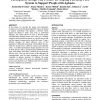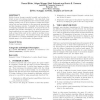527 search results - page 39 / 106 » Design beyond human abilities |
SIGCSE
2002
ACM
13 years 8 months ago
2002
ACM
Empirical evidence shows the ability for computer technology to deliver on its promises of enhancing our quality of life relies on how well the application fits our understanding ...
CHI
2006
ACM
14 years 9 months ago
2006
ACM
In this paper, we describe the design and preliminary evaluation of a hybrid desktop-handheld system developed to support individuals with aphasia, a disorder which impairs the ab...
CHI
2009
ACM
14 years 9 months ago
2009
ACM
In this paper, we present the design of ViVA, a visual vocabulary for aphasia. Aphasia is an acquired language disorder that causes variability of impairments affecting individual...
MHCI
2009
Springer
14 years 3 months ago
2009
Springer
Mobile devices became powerful recently and wireless Internet access is becoming standard. One important class of networked, mobile applications are location based games, making e...
DUX
2007
14 years 21 days ago
2007
The mobile phone is one of the most commonly carried pieces of personal, readily accessible digital technologies. Beyond just voice calls, they function as digital cameras, PDAs, ...




